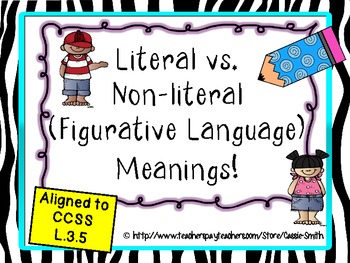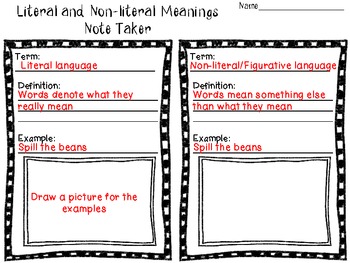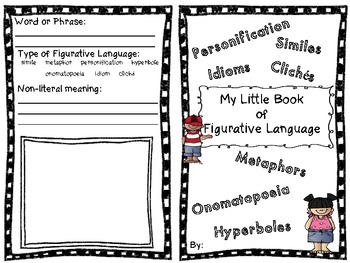Literal vs. Non-literal Meanings (Figurative Language)~ L.3.5
Cassie Carr
1.5k Followers
What educators are saying
Perfect resource to break down the skill, practice some as a small group and then give my students time to independently demonstrate knowledge of the skill!
Description
In this pack you will get all the printables you'll need to teach literal vs. non-literal language (figurative language). Aligned to CCSS L.3.5.
What You Get:
~Literal vs. Non-Literal Word Meaning Note Taker: Use to introduce key vocabulary, definitions, examples and illustrate examples. Teacher key is included.
~"My Little Book of Figurative Language": Use to teach the following types of figurative language: alliteration, onomatopoeia, hyperbole, metaphors, similes, idioms, clichés and personification. Each page of the book has an area for the word or phrase, identifying the type of figurative language, giving the non-literal meaning and illustrating an example. A list of compiled examples of figurative language is provided. Teacher sample pages are included.
~Booklet Note Taker: This note taker can be used to introduce each figurative language type: alliteration, onomatopoeia, hyperbole, metaphors, similes, idioms, clichés and personification. On the mini-booklet pages students will fill in the term, complete a cloze definition and give examples. A teacher key is included.
~Idiom Class Book/Bulletin Board: For this activity students are given a card with an idiom. On their page they must give the idiom, the non-literal meaning and illustrations of each. Student pages can be compiled as a class book or displayed on a bulletin board. A book cover is included.
~"Finish this Cliché..." Class Book/Bulletin Board {fun extension activity!}: For this activity students are given a page with an unfinished common cliché. They will finish the cliché any way they would like-what they come up with is pretty funny! Each cliché is then illustrated. You can talk about the actual ending of each cliché at the end of the activity and what each one means. They love this activity! A class book cover is included to compile the pages in a book or they could be displayed on a bulletin board.
Enjoy and please leave feedback! :)
What You Get:
~Literal vs. Non-Literal Word Meaning Note Taker: Use to introduce key vocabulary, definitions, examples and illustrate examples. Teacher key is included.
~"My Little Book of Figurative Language": Use to teach the following types of figurative language: alliteration, onomatopoeia, hyperbole, metaphors, similes, idioms, clichés and personification. Each page of the book has an area for the word or phrase, identifying the type of figurative language, giving the non-literal meaning and illustrating an example. A list of compiled examples of figurative language is provided. Teacher sample pages are included.
~Booklet Note Taker: This note taker can be used to introduce each figurative language type: alliteration, onomatopoeia, hyperbole, metaphors, similes, idioms, clichés and personification. On the mini-booklet pages students will fill in the term, complete a cloze definition and give examples. A teacher key is included.
~Idiom Class Book/Bulletin Board: For this activity students are given a card with an idiom. On their page they must give the idiom, the non-literal meaning and illustrations of each. Student pages can be compiled as a class book or displayed on a bulletin board. A book cover is included.
~"Finish this Cliché..." Class Book/Bulletin Board {fun extension activity!}: For this activity students are given a page with an unfinished common cliché. They will finish the cliché any way they would like-what they come up with is pretty funny! Each cliché is then illustrated. You can talk about the actual ending of each cliché at the end of the activity and what each one means. They love this activity! A class book cover is included to compile the pages in a book or they could be displayed on a bulletin board.
Enjoy and please leave feedback! :)
Total Pages
45 pages
Answer Key
N/A
Teaching Duration
N/A
Report this resource to TPT
Reported resources will be reviewed by our team. Report this resource to let us know if this resource violates TPT’s content guidelines.





